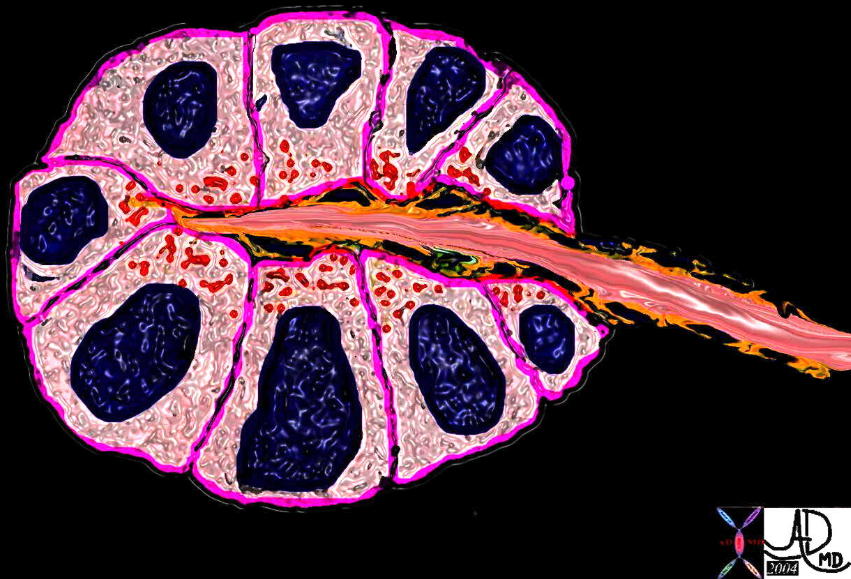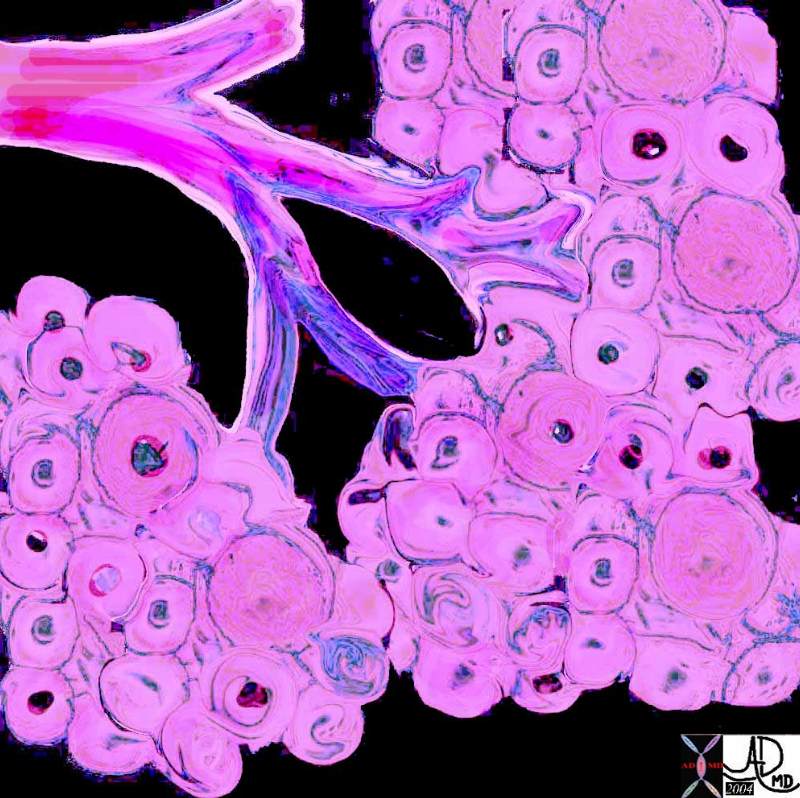Structure
Copyright 2007
In this section we attempt to put the structure and function of the breast in the context of the principles that govern structure and function in other parts of the body. When we look at the body as a whole we note for example that there are glands, supportive tissues, conducting and transport systems, protective systems, and controlling systems. Each organ usually has elements of all of these but is specialized to perform one of these functions that characterize it as a functional component of the body. The breast is a glandular organ, and is in fact a modified sweat gland

Glands Around a Duct |
|
This is a classic example of a simple, single layered epithelium surrounding a central ductule. This histology is taken from the stomach but the structure is common to many other glands in the body 12269 Courtesy Barbara Banner MD |
A gland is a collection of epithelial cells that produce a substance that is necessary for body function. In the case of the breast the functional substance produced is milk. The breast is a modified apocrine sweat gland. An apocrine gland is characterized by its mode of secretion where the secretion is pinched off from the apex of the cell and secreted into a duct that is about ten times larger than the duct of an eccrine sweat gland. Hair follicles are connected to an apocrine gland system. The larger diameter in the transport system of the apocrine gland is a necessary prerequisite to transport and store thick secretions. In the case of the breast, the thick secretion is milk. Storage of milk in the ducts places an unusual demand on the ductal system. One may think of this function as a mechanism to ensure that sufficient milk for the infant is available. The viscous secretion on the other hand may become impacted in the ducts and secondary obstruction and mastitis can result.

Glands Around a Duct |
|
A classical acinus, with a simple single layered epithelium surrounding a central lumen and subtended by a ductule 39939b04 Courtesy Ashley Davidoff MD |
The other type of sweat gland that does not store secretion in the ducts is called an eccrine gland. Once secretion takes place, the sweat is immediately transported to the surface of the skin.
Milk is a life sustaining nutrient for all mammalian newborns since it contains all the nutritional needs of the infant together with antibodies that are necessary to protect the baby who requires about 6 months to develop an adequate and independent immune system.
The glandular portion of the breast is an example of a compound tubuloalveolar gland. As a “compound” gland it implies that the ductal portion is branched. As a “tubuloalveolar” gland it is implied that the secretory element of the gland has both tubular and alveolar (grape-like) elements.
The transport system is a tube, and flow will depend on pressure differences across the tube, resistance, diameter length and viscosity of the medium being transported.

Acinar Glands Around a Duct |
|
The classical bunch of grapes morphology of the glandular structure is shown in the above diagram. he breast is a tubuloalveolar gland which changes depending on the phase of the cycle, but in general takes on the above morphology diring lactation. 32645a06 Courtesy Ashley Davidoff MD |
As an anatomical structure, the breast will be defined by descriptive features including size, shape, position, and character. There will be a normal range for these elements, and abnormality will be recognized when these structural norms are disturbed by disease. These concepts govern and are applied in the evaluation of structures in pathology, radiology and clinical medicine. While size, shape, and position are self explanatory, character refers to how the structure looks feels and behaves when evaluated by the tools of the clinician, radiologist or pathologist.
As a biological structure it will require lifeline connections including blood supply, venous drainage, and lymphatics. Vascular connections include arteries from the internal mammary and lateral thoracic arteries, while venous drainage is from similarly named veins.
All biological entities have a protective cover which in the case of the breasts is an outer layer of skin. Internally it is supported and protected by a thin, relatively flimsy capsule, together with fascial layers, Cooper’s ligaments, and surrounding fat. The breast rests on the pectoralis muscle.
For its functionality it depends on the organization of its glands and ducts which as noted consist of 10-15 radially positioned lobules that terminate at the nipple.
The broad principles of space and time also apply to the breast. The breast occupies space and shares the space only with the structures of the anterior chest wall.
The breast changes with time and shows dramatic structural change during puberty, pregnancy, lactation, and aging.
